Overview
The article titled "10 Essential Project Manager Roles and Responsibilities for Startups" highlights the pivotal roles and responsibilities project managers must undertake to drive startup success. It underscores the significance of clear communication, effective risk management, budget oversight, and adaptability to changes. These elements are crucial for steering projects toward successful outcomes within a dynamic business landscape.
What does it take to ensure your startup thrives? Project managers play a vital role in navigating the complexities of startup environments. By fostering clear communication, they bridge gaps between teams and stakeholders, ensuring everyone is aligned with project goals. Additionally, effective risk management allows project managers to identify potential pitfalls before they escalate, safeguarding the project's trajectory.
Budget oversight is another key responsibility, as it ensures resources are allocated efficiently, maximizing the potential for success. Moreover, adaptability to changes is essential in today's fast-paced business world, allowing project managers to pivot strategies as necessary.
In conclusion, understanding these essential roles equips startup founders with the insights needed to leverage project management effectively. Embracing these responsibilities not only enhances project outcomes but also positions startups for long-term success.
Introduction
Navigating the startup landscape is no small feat, particularly when it comes to effective project management. Entrepreneurs face the challenge of limited resources and high stakes, necessitating a strategic approach to ensure success. This article explores ten essential roles and responsibilities of project managers that can empower startups to thrive.
From automating task management with innovative tools like Casy to fostering team collaboration and mitigating risks, these insights are crucial for any founder. However, as startups strive for efficiency and growth, how can they balance the demands of project management with the need for flexibility and adaptability in an ever-changing environment?
Casy: Automate Task Management for Enhanced Productivity
Casy revolutionizes project oversight by automating task creation and updates directly from group communications. By integrating seamlessly with platforms like Slack and Telegram, it captures essential information and converts it into actionable tasks. This automation alleviates the administrative burden on teams, allowing them to focus on their core activities and significantly enhances overall productivity. For instance, a small fintech company managed to reduce their weekly standup meeting duration from 45 minutes to just 12 minutes by automating task management, reclaiming nearly 30 hours annually for each team member.
Startups can harness Casy to streamline their workflows, ensuring that no critical task is overlooked while minimizing manual input and coordination efforts. As Caleb Oranye aptly states, "Automation isn’t a luxury. It’s the backbone of new business survival and growth." Furthermore, Casy employs methodologies such as OKRs and the Eisenhower Matrix to help teams prioritize their tasks efficiently. By leveraging automated task management tools like Casy, startups can boost efficiency, maintain a focus on innovation and growth, and ultimately cultivate a more agile and responsive organization.
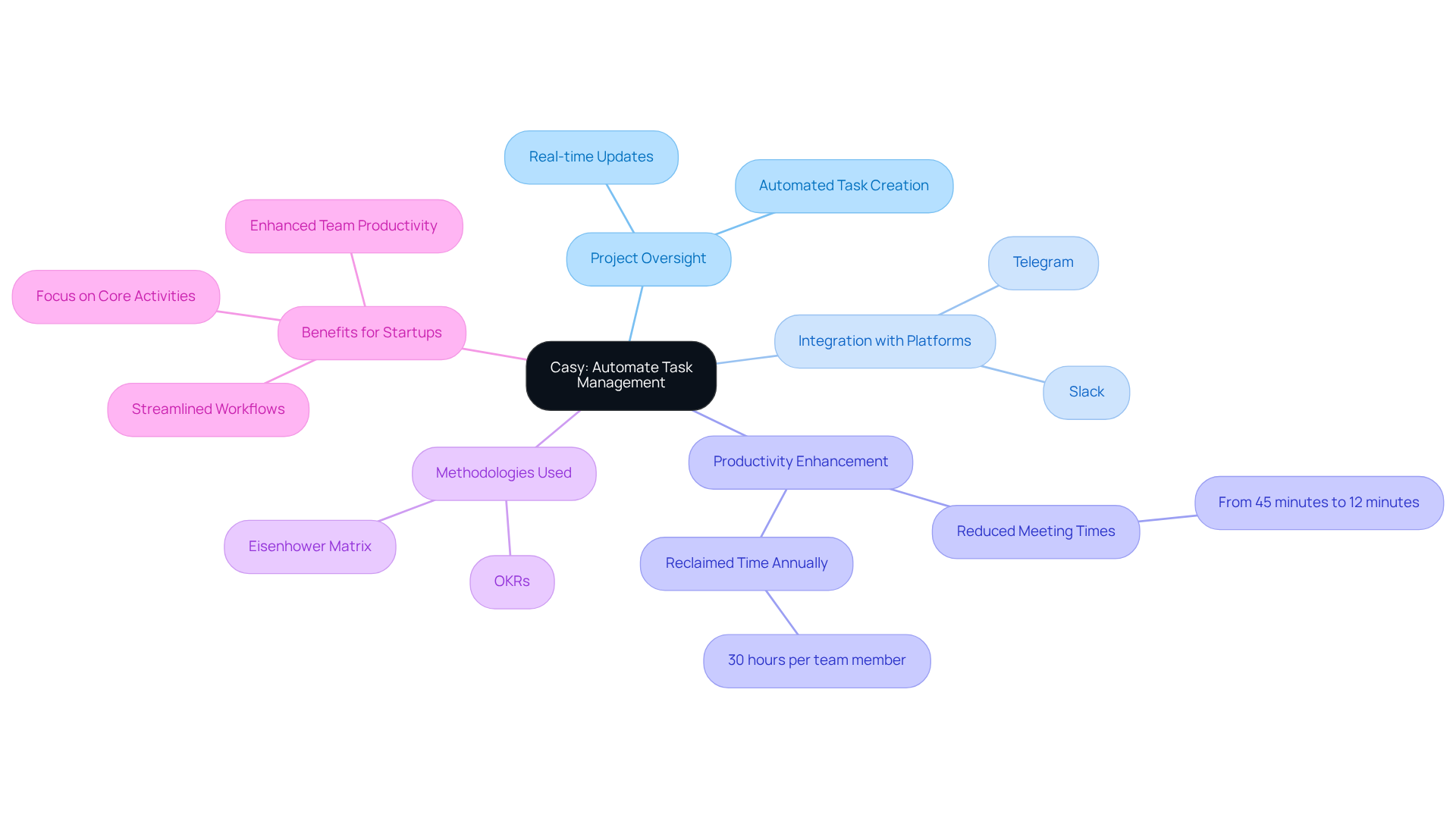
Define Project Scope and Objectives Clearly
Establishing a clear scope and objectives is crucial for effectively guiding your team and stakeholders. This process involves outlining the initiative's deliverables, timelines, and key milestones. Startups should leverage the SMART framework—Specific, Measurable, Achievable, Relevant, and Time-bound—to create well-defined objectives. For example, a startup might set a SMART goal to:
- Increase sales by 20% within six months
- Launch a social media campaign within four weeks
This organized clarity not only helps manage expectations but also serves as an essential reference throughout the lifecycle of the project. By adhering to SMART criteria, teams can maintain focus, make informed decisions, and adapt to changes, ultimately enhancing project success. Regular progress evaluations against these SMART objectives are vital, as they allow teams to assess their trajectory and implement necessary adjustments.
However, beware of the pitfall of concentrating too heavily on short-term goals; this can lead to losing sight of the bigger picture. As stated, 'The ability to set SMART goals gives you an undeniable edge over those who don’t,' underscoring the importance of clear objectives in boosting performance and accountability in today's fast-paced business environment.
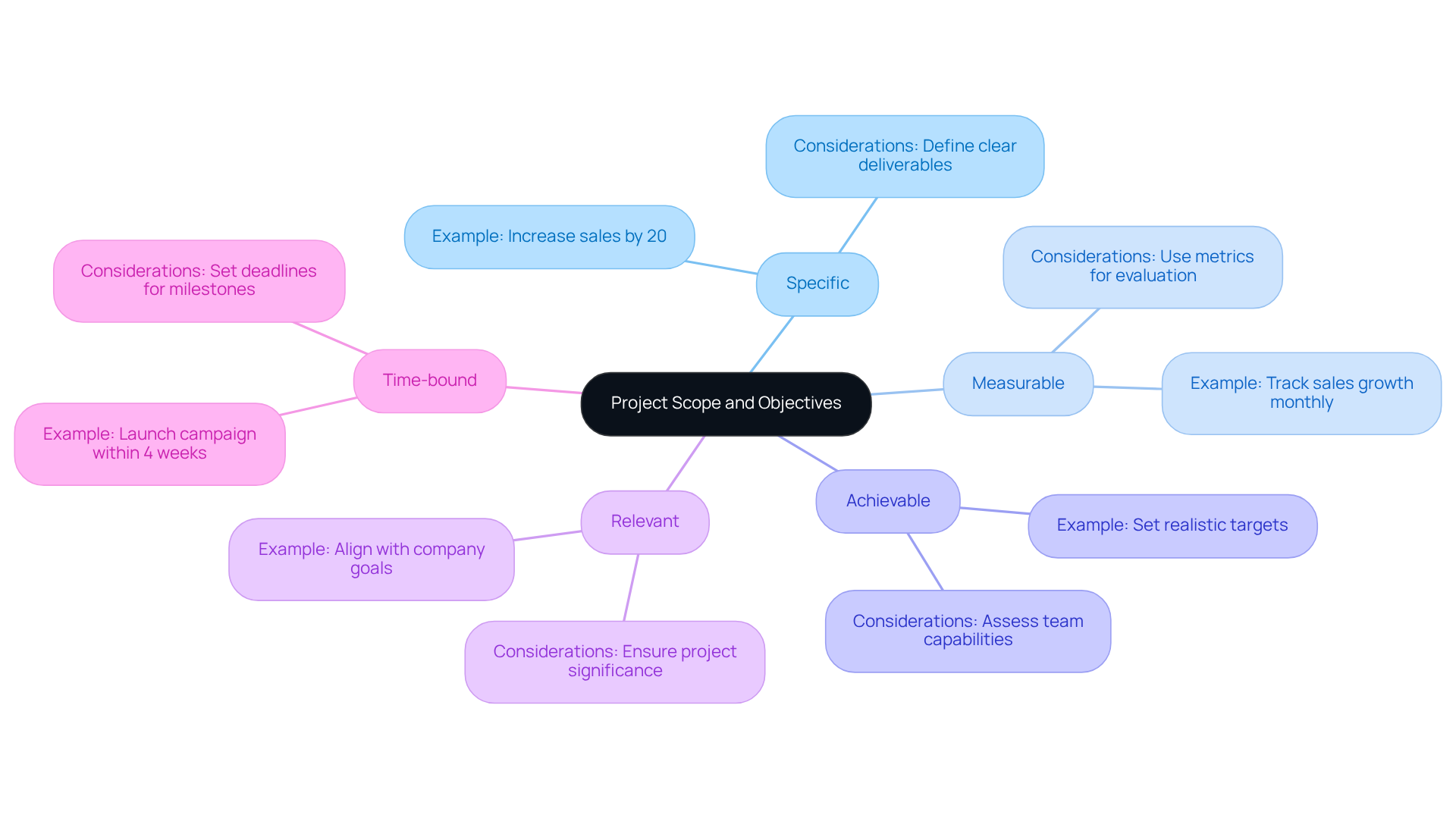
Facilitate Team Communication and Collaboration
To enhance efficient group communication, new businesses must establish regular check-ins and leverage collaborative tools that allow for real-time updates and feedback. Consider platforms like Casy, which can significantly improve communication by automatically capturing discussions and transforming them into actionable tasks. Moreover, fostering a culture of openness and transparency is essential; it not only aids in swiftly resolving conflicts but also encourages a sense of ownership among team members. Ultimately, these practices lead to improved outcomes. Are you ready to elevate your team's communication strategy?
Track Project Progress and Performance Metrics
To effectively monitor progress in their initiatives, startups must establish key performance indicators (KPIs) that encompass essential metrics such as:
- Task completion rates
- Budget adherence
- Timeline accuracy
Consider this: an initiative that consumed 70% of total hours while generating only 30% of revenue serves as a cautionary example. This highlights the critical need for precise tracking to optimize resource allocation.
Employing management tools like Casy can significantly improve this process by automating the tracking of these metrics, offering real-time insights into status without the burden of manual updates. Furthermore, defining SMART KPIs—Specific, Measurable, Achievable, Relevant, and Time-bound—ensures that the metrics align with objectives.
Frequently assessing these performance metrics not only assists in making informed choices but also guarantees that initiatives stay aligned with their goals. This proactive strategy is essential, particularly in 2025, as startups encounter rising competition and the necessity for flexible task oversight. By utilizing KPIs, groups can recognize potential problems early, modify strategies accordingly, and ultimately achieve success.
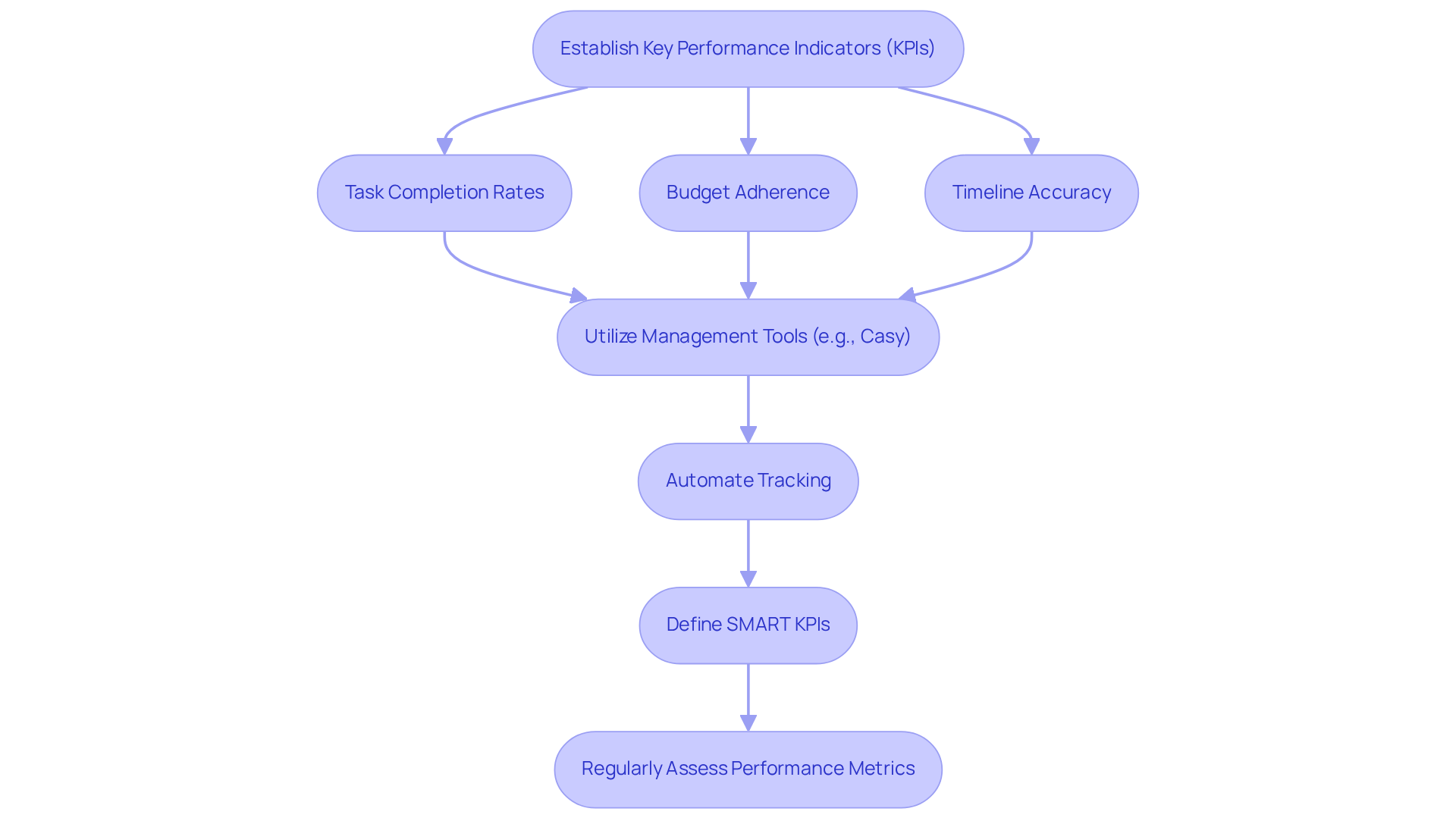
Identify and Mitigate Project Risks
Effective risk management begins with the early recognition of potential risks in the lifecycle, followed by the formulation of robust strategies to mitigate them. Startups must conduct regular risk assessments and maintain a risk register to meticulously track identified risks and their corresponding mitigation plans. By fostering a culture of awareness and responsiveness, teams can adeptly adjust to emerging challenges, thereby minimizing their impact on timelines and deliverables. Are you prepared to embrace this proactive approach to risk management?
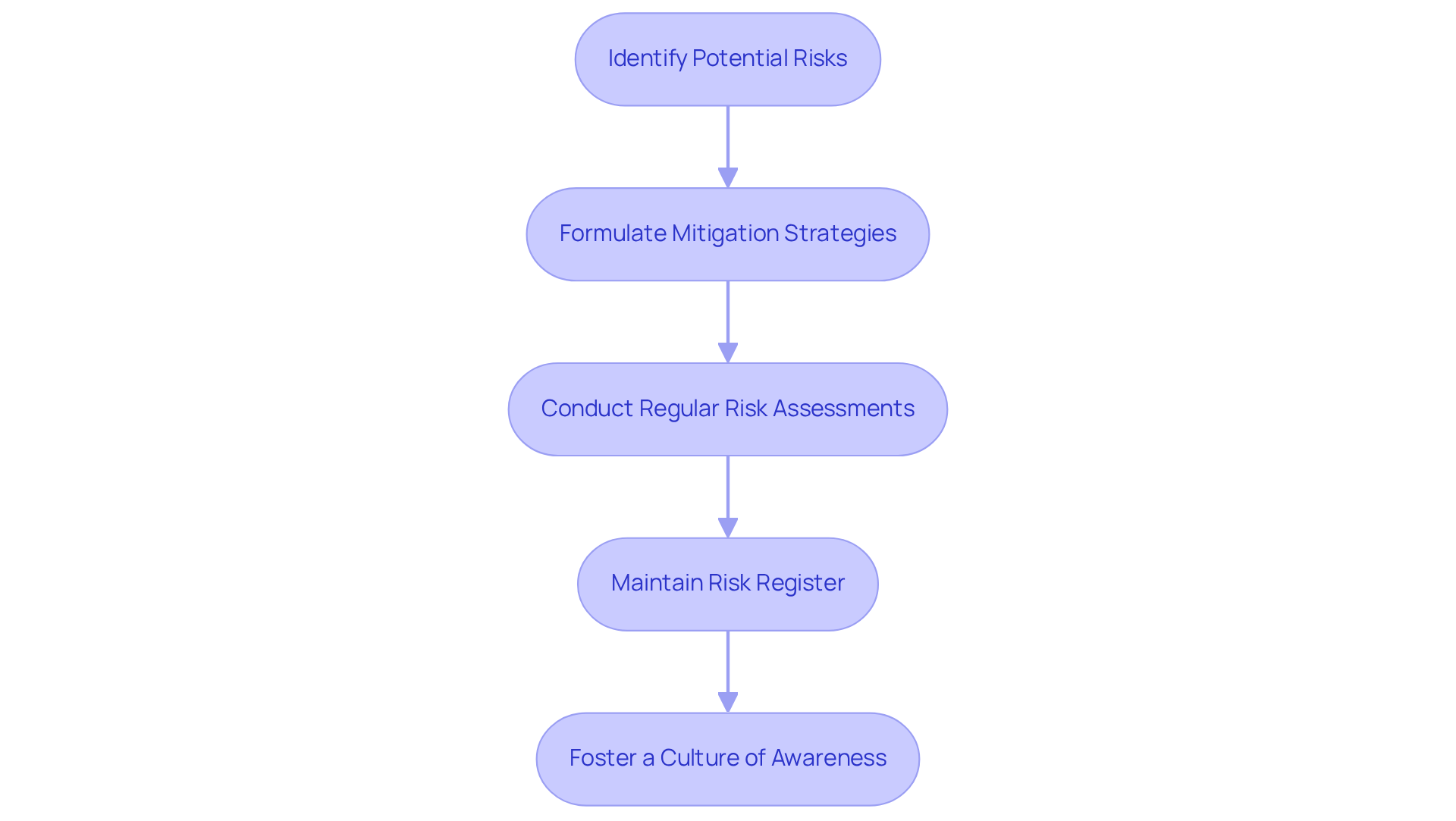
Manage Project Budgets and Resources Effectively
Startups must establish a comprehensive budget that outlines all expected expenses and resource allocations. By leveraging tools like Casy, teams can monitor expenses in real-time, facilitating timely adjustments to spending as needed. This proactive approach, coupled with regular budget assessments and resource evaluations, ensures that initiatives remain financially viable and that resources are utilized effectively. Such practices not only enhance financial oversight but also significantly contribute to the overall success of projects.
Did you know that 38% of new businesses fail due to depleting funds? This statistic underscores the essential requirement for efficient budget management. Furthermore, the global budgeting software market is projected to grow to $2.16 billion by 2029, highlighting the increasing relevance of tools like Casy in supporting startups' financial health.
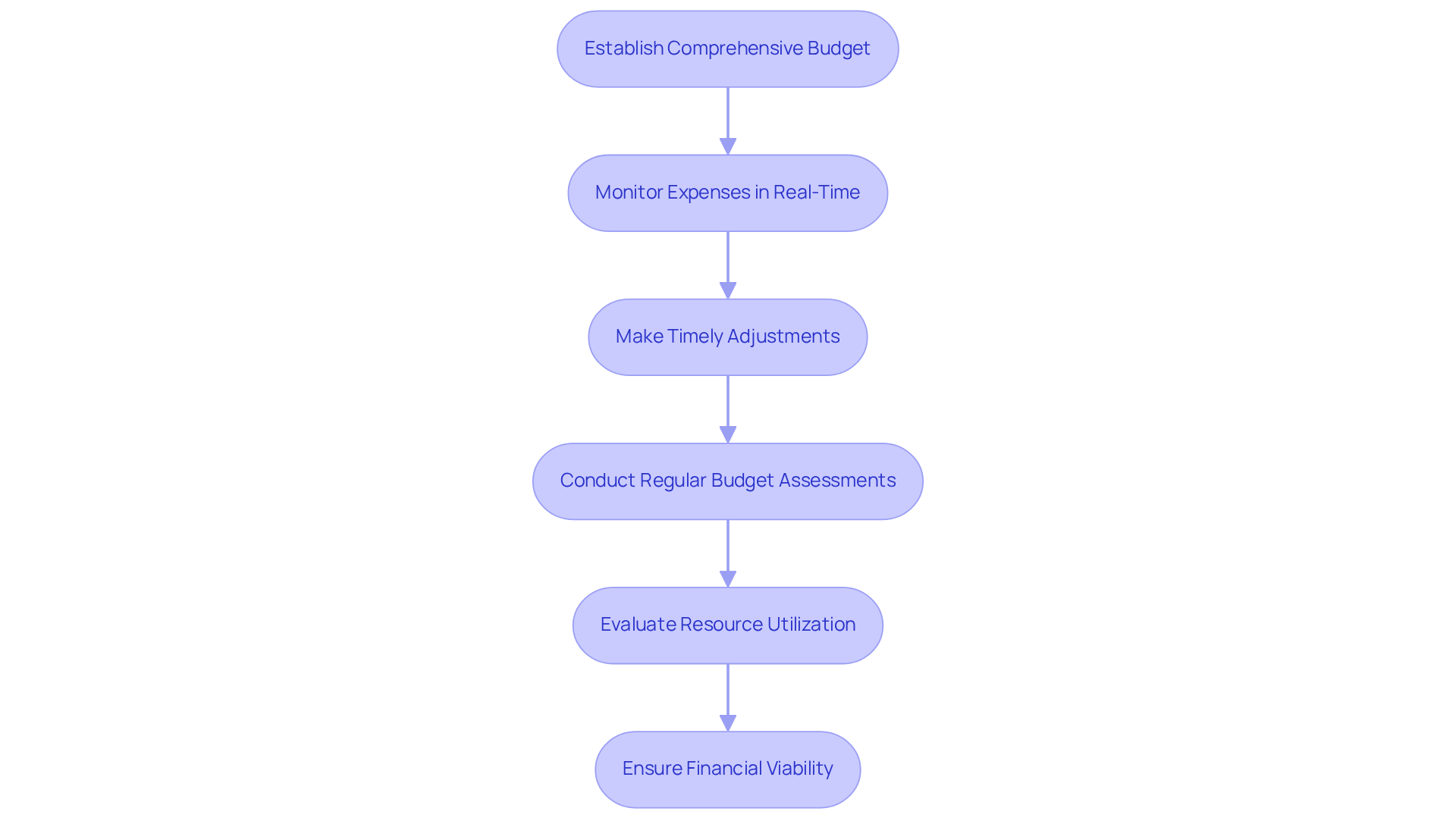
Ensure Quality Control and Standards Compliance
Implementing robust quality control measures throughout the initiative lifecycle is essential for ensuring that deliverables meet established standards. Startups must define clear quality criteria from the outset and conduct regular assessments to identify any deviations. Research indicates that companies waste approximately 11.4% of their investments due to poor project performance. This statistic underscores the importance of maintaining high-quality outputs. By utilizing feedback loops and embracing continuous improvement practices, teams can refine their processes, enhance the quality of their deliverables, and ultimately boost customer satisfaction.
Consider this: new ventures that prioritize quality evaluations often observe a direct link between their dedication to standards adherence and enhanced client trust and loyalty. Furthermore, regulatory compliance is becoming increasingly crucial in quality management practices. It is essential for new businesses to incorporate these standards into the project manager roles and responsibilities within their project management strategies. The OODA Loop framework, which promotes ongoing observation and adjustment, serves as a practical resource for new businesses seeking to improve their quality control procedures. This proactive strategy not only reduces risks but also prepares new ventures for sustainable growth in a competitive environment.
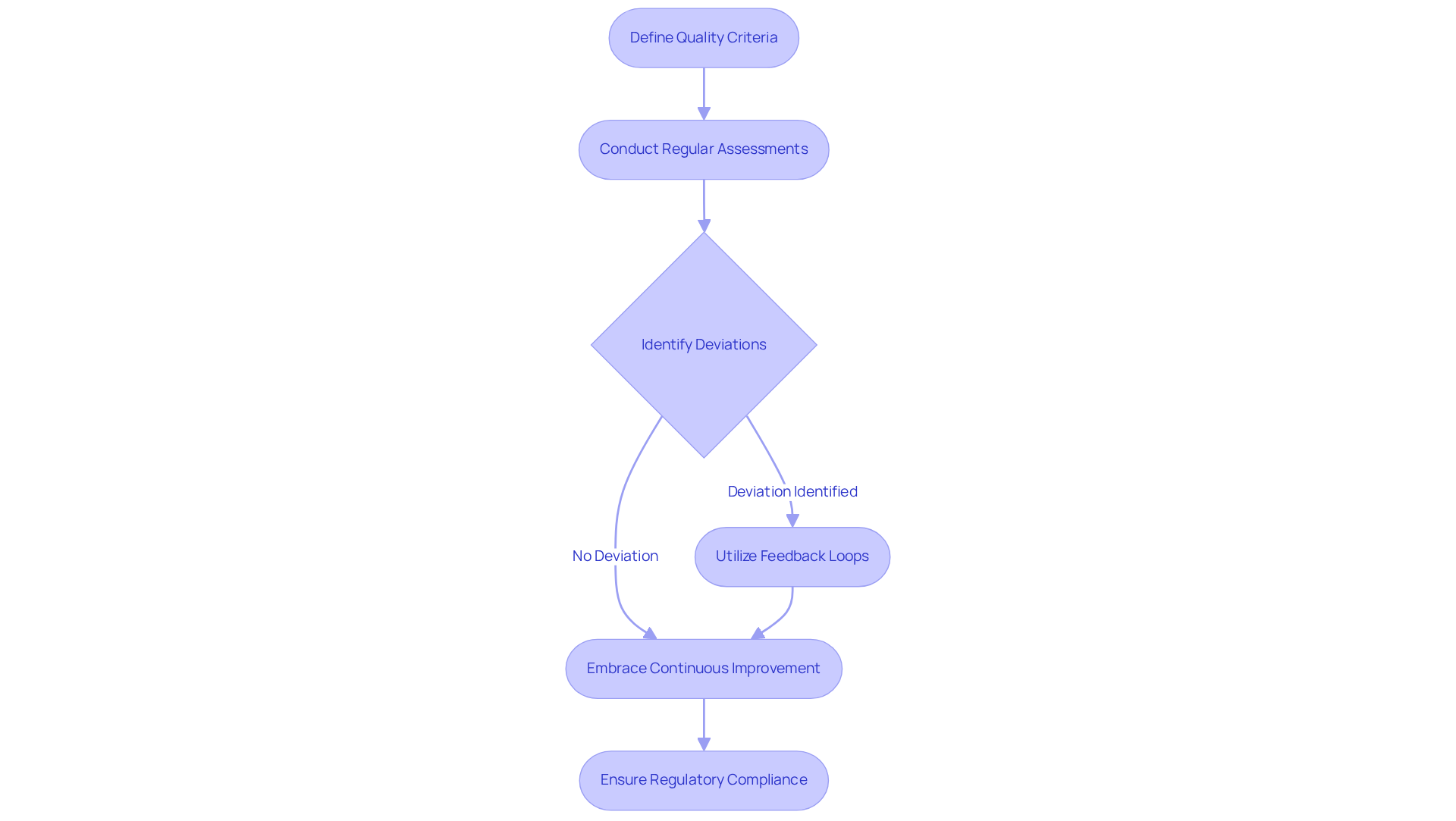
Engage and Manage Stakeholder Expectations
Creating a thorough stakeholder engagement strategy is crucial for new ventures, as it outlines how and when communication will take place throughout the initiative's lifecycle. Regular updates and transparent communication foster trust, keeping stakeholders informed about progress and challenges. However, limited resources and bandwidth can hinder consistent stakeholder engagement, underscoring the necessity for effective strategies.
Actively involving stakeholders in decision-making processes not only aligns their expectations with project goals but also cultivates stronger support for the initiative. For instance, companies like Slack have effectively engaged their user base by emphasizing feedback, resulting in improved product development and brand loyalty. Similarly, Airbnb's collaboration with local hosts exemplifies how effective stakeholder engagement can drive rapid scaling and community support.
Furthermore, Elon Musk’s transparency with investors and customers has been a cornerstone of Tesla’s growth, demonstrating the significant impact of open communication on trust. By recognizing the evolving nature of stakeholder relationships and employing tailored communication strategies, including omnichannel engagement approaches, startups can navigate complexities and ensure sustained growth.
Are you ready to implement these strategies and transform your stakeholder engagement approach?
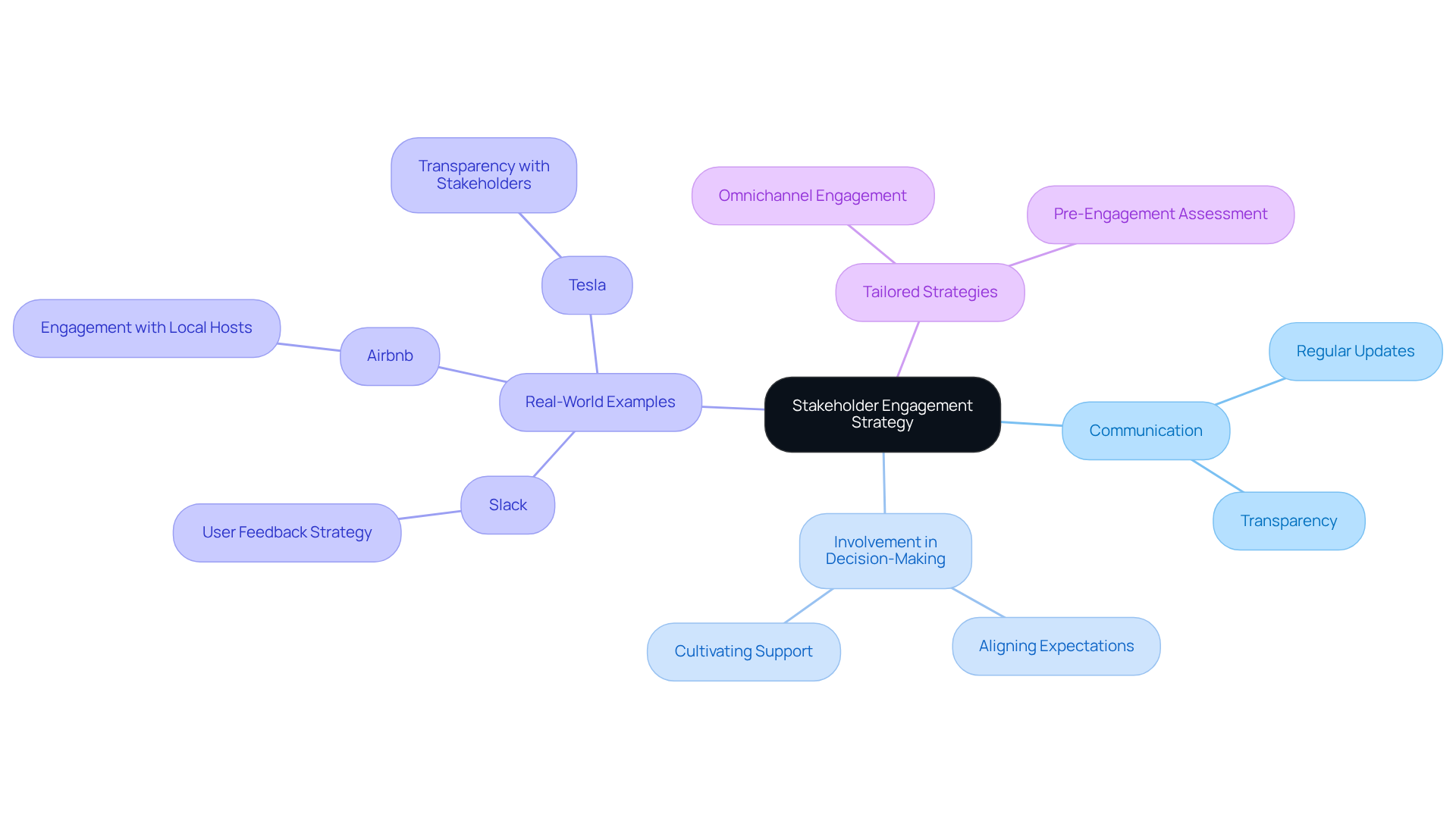
Adapt to Changes and Manage Project Adjustments
Startups must adopt a flexible management approach that facilitates necessary adjustments. This entails performing regular evaluations of plans and remaining open to input from colleagues and stakeholders. By cultivating a culture of adaptability, teams can effectively respond to changes in project scope, timelines, or resources, ensuring alignment with overarching business objectives. Flexibility is not merely advantageous; it is crucial for navigating the dynamic environment of business operations.
Consider this: a technology company successfully shifted its focus from healthcare to education software during the online learning surge. This example demonstrates how responsiveness to market demands can drive success. Furthermore, research indicates that companies embracing agile methodologies are more likely to thrive in competitive environments, as they can quickly pivot and capitalize on new opportunities.
Looking ahead, in 2025, companies that emphasize flexibility in their management practices will be better prepared to navigate the intricacies of contemporary business. This adaptability will ultimately result in enhanced outcomes and sustained growth. Are you ready to embrace flexibility and position your startup for success?
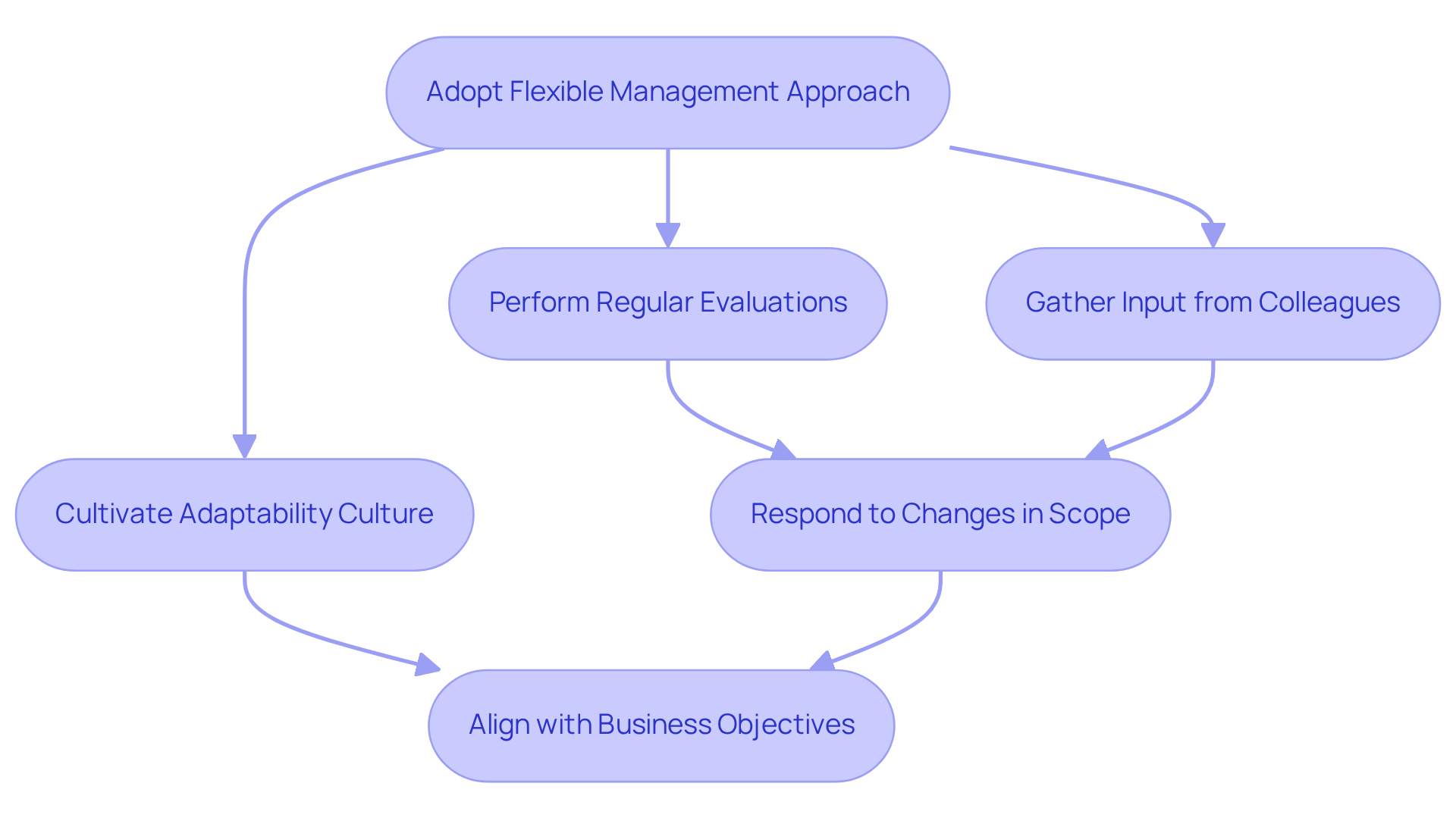
Conduct Post-Project Reviews and Learnings
Upon completing the initiative, startups must engage in comprehensive post-initiative reviews (PPRs) to evaluate successes and identify areas for improvement. This essential process includes:
- Gathering feedback from team members and stakeholders
- Analyzing key performance metrics
- Meticulously documenting lessons learned
By employing a structured retrospective approach—establishing the tone, reflecting on experiences, and addressing unique situations—teams can pinpoint effective practices and areas that require refinement, thereby nurturing a culture of continuous improvement. This iterative learning process not only enhances team efficiency but also significantly boosts the likelihood of success in future endeavors.
Have you considered how previous insights can shape your next steps? Startups that actively implement lessons from past initiatives often see improved outcomes, as they can adapt strategies based on real-world experiences. It is crucial to conduct PPRs within 1-2 months post-closure to ensure timely feedback.
Furthermore, gathering diverse perspectives during these evaluations guarantees comprehensive insights, while documenting key findings and action items helps build a knowledge base for future projects. As we look toward 2025, the focus on learning from project outcomes will be vital for startups striving to navigate the complexities of their growth trajectories effectively.
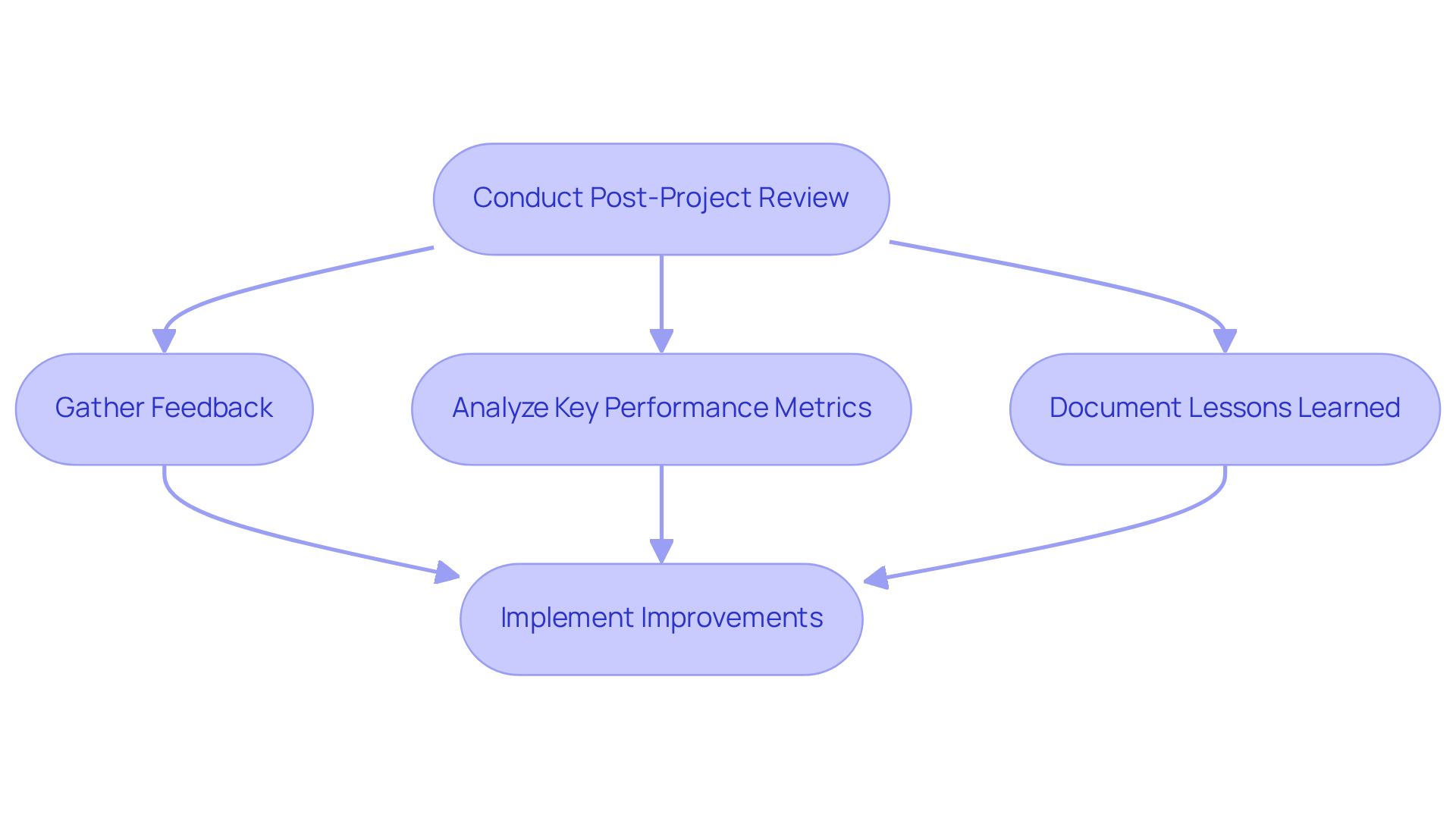
Conclusion
Startups encounter distinctive challenges in project management, making the roles and responsibilities of project managers essential for success. By adopting key practices such as:
- Automating task management with tools like Casy
- Clearly defining project scope using the SMART framework
- Fostering effective team communication
startups can significantly enhance their operational efficiency. Additionally, managing budgets wisely, implementing quality control measures, and engaging stakeholders transparently are vital components that contribute to achieving project goals.
The insights shared throughout this article underscore the importance of a structured approach to project management. From tracking performance metrics to adapting to changes and conducting thorough post-project reviews, each element plays a significant role in ensuring that startups not only survive but thrive in competitive environments. By prioritizing these practices, new businesses can cultivate a culture of continuous improvement and responsiveness, ultimately leading to greater innovation and success.
As the landscape of business continues to evolve, the ability to adapt and learn from past experiences will be paramount. Startups are encouraged to embrace these strategies and tools to navigate their growth trajectories effectively. By doing so, they position themselves not just for immediate success, but for sustainable growth and resilience in the face of future challenges.
Frequently Asked Questions
What is Casy and how does it enhance productivity?
Casy is a task management automation tool that integrates with platforms like Slack and Telegram. It automates task creation and updates from group communications, reducing the administrative burden on teams and allowing them to focus on their core activities, which significantly enhances overall productivity.
How did a fintech company benefit from using Casy?
A small fintech company reduced their weekly standup meeting duration from 45 minutes to just 12 minutes by using Casy for task management, reclaiming nearly 30 hours annually for each team member.
What methodologies does Casy employ to help teams prioritize tasks?
Casy employs methodologies such as OKRs (Objectives and Key Results) and the Eisenhower Matrix to help teams prioritize their tasks efficiently.
What is the SMART framework and how can startups use it?
The SMART framework stands for Specific, Measurable, Achievable, Relevant, and Time-bound. Startups can use it to create well-defined objectives, such as increasing sales by 20% within six months or launching a social media campaign within four weeks, which helps manage expectations and enhances project success.
Why is it important to regularly evaluate progress against SMART objectives?
Regular progress evaluations against SMART objectives allow teams to assess their trajectory, make informed decisions, and implement necessary adjustments, ultimately enhancing project success.
What are some recommended practices for facilitating team communication and collaboration?
New businesses should establish regular check-ins, leverage collaborative tools for real-time updates and feedback, and foster a culture of openness and transparency to improve communication and encourage a sense of ownership among team members.
How can automating task management impact team communication?
Automating task management with tools like Casy can significantly improve communication by automatically capturing discussions and transforming them into actionable tasks, leading to better outcomes for the team.




